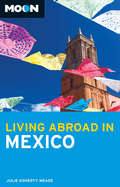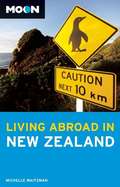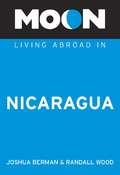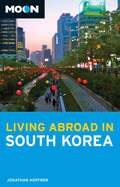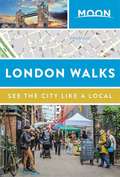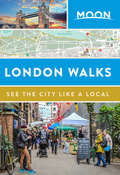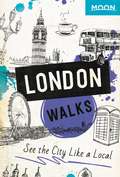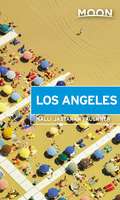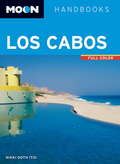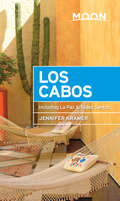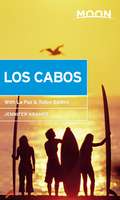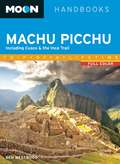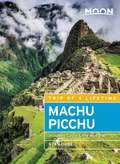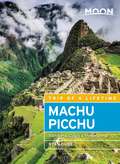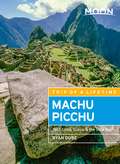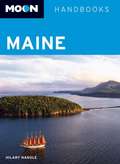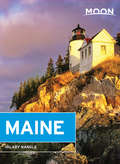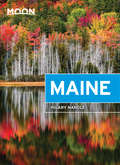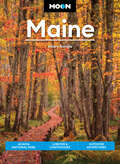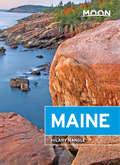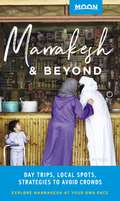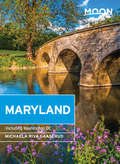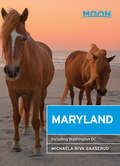- Table View
- List View
Moon Living Abroad in Mexico
by Julie Doherty MeadeLongtime Mexico resident Julie Doherty Meade has the inside track on what it takes to make the move to Mexico. In Moon Living Abroad in Mexico, she uses her firsthand knowledge to offer advice on navigating the language and culture of this warm, welcoming country, and outlines all the information you need to manage your move abroad in a smart, organized, and straightforward manner.Moon Living Abroad in Mexico is packed with essential information and must-have details on setting up daily life, including obtaining visas, arranging finances, gaining employment, choosing schools, and finding health care. With color and black and white photos, illustrations, and maps to help you find your bearings, Moon Living Abroad in Mexico makes it easy for businesspeople, adventurers, students, teachers, professionals, families, couples, and retirees to transition to a life abroad.
Moon Living Abroad in New Zealand
by Michelle WaitzmanMichelle Waltzman fell in love with New Zealand’s stunning landscapes and various outdoor activities on a backpacking trip in 1998, and has since moved to the country, recently obtaining permanent resident status. Michelle provides insight and first-hand advice on all that living in New Zealand has to offer. She outlines all the information needed in a smart, organized, and straightforward manner, making planning the move abroad manageable. Moon Living Abroad in New Zealandmakes the moving and transition process easy for businesspeople, students, teachers, retirees, and professionals. Moon Living Abroad in New Zealandis packed with essential information and must-have details on setting up daily life including obtaining visas, arranging finances, gaining employment, choosing schools, and finding health care. This relocation guide also includes practical advice on how to rent or buy a home for a variety of needs and budgets, whether it’s an apartment in cosmopolitan Wellington or a home in historic Christchurch. All Moon Living Abroad Guides include color photos, black and white photos, black and white illustrations, and maps.
Moon Living Abroad in Nicaragua
by Randall Wood Joshua BermanCentral America experts Joshua Berman and Randall Wood know what it takes to make the move to Nicaragua - both have left the U.S. to make their homes there. In Moon Living Abroad in Nicaragua, they share their firsthand advice on transplanting to Nicaragua, ensuring that you have all the tools you need to navigate the ins and outs of the moving process. The guide is packed with essential information and must-have details on setting up daily life, including obtaining visas, arranging finances, gaining employment, choosing schools, and finding health care. Berman and Wood also include practical advice on how to rent or buy a home for a variety of needs and budgets. With extensive color and black-and-white photos, illustrations, and maps, Moon Living Abroad in Nicaragua will help you find your bearings as you settle into your new home and life abroad.
Moon Living Abroad in South Korea
by Jonathan HopfnerJonathan Hopfner has made the move to South Korea-twice. His experience as a journalist, investor, and homeowner has taught Jonathan the ins and outs of living in South Korea-from the banking and business realities, to the immigration and business procedures. It is this firsthand experience and advice that Jonathan brings to Moon Living Abroad in South Korea.Moon Living Abroad in South Korea is packed with essential information and must-have details on setting up daily life, including obtaining visas, arranging finances, and gaining employment. You'll get practical advice on education, health care, and how to rent or buy a home that fits your needs. The book also includes color and black and white photos, illustrations, and maps-making the moving and transition process easy for businesspeople, students, teachers, retirees, and professionals.
Moon Living Abroad in Thailand
by Suzanne NamMoon Thailand author and Bangkok resident Suzanne Nam knows what it takes to make the move to Thailand. As a dedicated travel writer who has lived in Thailand for more than four years, Nam has the firsthand know-how and insight to help you make a smooth transition to life in Southeast Asia. Moon Living Abroad in Thailand is packed with essential information and must-have details on setting up daily life, including obtaining visas, arranging finances, and gaining employment. Nam also includes particulars on education, health care, and how to rent or buy a home that fits your needs. With color and black and white photos, illustrations, and maps to help you find your way, Moon Living Abroad in Thailand is an indispensable resource for tourists, business people, adventurers, students, teachers, professionals, families, couples, and retirees looking to relocate.
Moon London Walks
by Moon Travel GuidesExperience London like a local: on foot! Whether you're shopping on the high street, strolling lively street markets, or admiring renowned modern art, discover London's highlights and local favorites with Moon London Walks. This full-color guide features: Six customizable walks through the city's hippest neighborhoods, including Shoreditch, Chelsea, Marylebone, and more, with color-coded stops and turn-by-turn directions; Foldout maps of each route and a removable full-city map, in a handy, portable guide; Curated "Top Ten" lists for restaurants, nightlife, markets, and Sunday activities; The top attractions and the best-kept local secrets: Head to Portobello Road Market to browse vintage treasures, or treat yourself at upscale department stores like Harrods. Make your way to the Tate Modern and other world-famous art galleries, take in London's history at Westminster Abbey, and watch the changing of the guards at Buckingham Palace. Take a leisurely stroll through Regent's Park, enjoy afternoon tea at a stylish hotel, or grab a pint and some fish and chips before heading to the theatre. Sip craft cocktails in an old train station, discover the hippest new gastropub, or watch the sun set over the city from a chic rooftop barPublic transportation options, including the underground, public buses, and taxis Practical tips for first-time visitors, including average costs, where you'll need to make a reservation, public holidays, and getting to and from the airport. With creative routes, public transit options, and a full-city map, you can explore London at your own pace, without missing a beat.
Moon London Walks (Travel Guide)
by Moon Travel GuidesExperience London like a local: on foot!Whether you're shopping on the high street, strolling lively street markets, or admiring renowned modern art, discover London's highlights and local favorites with Moon London Walks. This full-color guide features:Six customizable walks through the city's hippest neighborhoods, including Shoreditch, Chelsea, Marylebone, and more, with color-coded stops and turn-by-turn directionsFoldout maps of each route and a removable full-city map, in a handy, portable guideCurated "Top Ten" lists for restaurants, nightlife, markets, and Sunday activitiesThe top attractions and the best-kept local secrets: Head to Portobello Road Market to browse vintage treasures, or treat yourself at upscale department stores like Harrods. Make your way to the Tate Modern and other world-famous art galleries, take in London's history at Westminster Abbey, and watch the changing of the guards at Buckingham Palace. Take a leisurely stroll through Regent's Park, enjoy afternoon tea at a stylish hotel, or grab a pint and some fish and chips before heading to the theatre. Sip craft cocktails in an old train station, discover the hippest new gastropub, or watch the sun set over the city from a chic rooftop barPublic transportation options, including the underground, public buses, and taxisPractical tips for first-time visitors, including average costs, where you'll need to make a reservation, public holidays, and getting to and from the airportWith creative routes, public transit options, and a full-city map, you can explore London at your own pace, without missing a beat.Check out our guides to more of the world's liveliest cities, so you can hit the ground running! Also available: Moon Barcelona Walks, Moon Berlin Walks, Moon New York Walks, Moon Amsterdam Walks, Moon Paris Walks, and Moon Rome Walks
Moon London Walks: See the City Like a Local (Travel Guide)
by Moon Travel Guides<p>Whether you're shopping on the high street, strolling lively street markets, or admiring renowned modern art, experience London like a local: on foot!<p> <p>Walk through the city's coolest neighborhoods like Shoreditch, Chelsea, Marylebone, and more, with color-coded stops and turn-by-turn directions<p> <p>Find your scene with top ten lists of the best restaurants, nightlife, markets, museums, and more<p> <p>Get to know the real London on six customizable walks: Find funky vintage treasures in Shoreditch or treat yourself at an upscale department store like Harrods. Make your way to the Tate Modern and other world-famous art galleries, take in London's history at Westminster Abbey, and watch the changing of the guards at Buckingham Palace. Take a leisurely stroll through Regent's Park, enjoy afternoon tea at a stylish hotel, or grab a pint and some fish and chips before heading to the theatre. Sip craft cocktails in an old train station, discover the hippest new gastropub, or watch the sun set over the city from a chic rooftop bar<p> <p>Escape the crowds at locally-loved spots and under-the-radar favorites<p> <p>Explore on the go with foldout maps of each walking route and a removable full-city map, all in a handy guide that fits in your pocket<p> <p>With creative routes, public transit options, and a full-city map, you can experience London at your own pace without missing a beat.<p>
Moon Los Angeles (Travel Guide)
by Halli Jastaran FaulknerGo hiking in Runyon Canyon, take a selfie with the Hollywood sign, and find the best taco truck in town: Experience the City of Angels with a local with Moon Los Angeles.Explore the City: Navigate by neighborhood or by activity with color-coded maps, or follow a self-guided neighborhood walkSee the Sights: Browse the boutiques in Silver Lake, take surfing lessons in Venice, or take a sunrise yoga class on the beach. Listen to the classics at the Disney Concert Hall, stroll the quirky Santa Monica Pier, or go back in time at the Getty VillaGet a Taste of the City: Dive into a kogi taco, savor soup dumplings, sample your way through a farmers market, and discover the best mole outside OaxacaBars and Nightlife: Relax with a craft beer in a gastropub, find the hottest new nightclub, mingle at a beachfront bar, or sip expertly made cocktails in a trendy speakeasyHonest Advice: LA local Halli Jastaran Faulkner shares her love of this sprawling metropolisStrategic Itineraries and Day Trips: Make the most of your trip with ideas for foodies, outdoor adventurers, film buffs, beach bums, and art lovers, or follow itineraries for day trips to Disneyland, Catalina Island, Orange County, and moreFull-Color Photos and Detailed Maps Handy Tools: Background information on LA's landscape, history, and culture, plus an easy-to-read foldout map to use on the goWith Moon Los Angeles' practical tips and local know-how, you can experience LA your way.Hitting the road? Check out Moon California Road Trip. Heading further south? Try Moon San Diego. Special ebook features:Sight listings include links to Google MapsEasily navigate listings with quick searches, website links, and zoom-in maps and imagesPersonalize your travel guide by adding notes and bookmarks
Moon Los Cabos
by Nikki Goth ItoiThis full-color guide to Los Cabos includes vibrant photos and helpful planning maps.Mexico enthusiast Nikki Goth Itoi knows the best ways to experience Los Cabos-from hiking in the Sierra de la Laguna to visiting the amazing Pulmo Reef, the only coral reef system in the Sea of Cortez. Itoi draws on her extensive knowledge of the area to provide themed trip ideas, such as Surf and Dive Spots and Cabo Nightlife, plus in-depth coverage of the many activities available to travelers. With insightful advice on finding secluded beaches, diving shipwrecks, and grabbing a bite in La Paz, Moon Los Cabos gives travelers the tools they need to create a more personal and memorable experience.This ebook and its features are best experienced on iOS or Android devices and the Kindle Fire.
Moon Los Cabos: Including La Paz & Todos Santos (Travel Guide)
by Jennifer KramerTravel writer and local guide Jennifer Kramer shares her expert perspective on Los Cabos, guiding you on a memorable and unique experience. Whether you're hiking in the Sierra de la Laguna or visiting the amazing Pulmo Reef, the only coral reef system in the Sea of Cortez, Moon Los Cabos has activities for every traveler. With itineraries like "Surf and Dive Spots” and "Cabo Nightlife,” expertly crafted maps, gorgeous photos, and Jennifer's trustworthy advice, Moon Los Cabos provides the tools for planning your perfect trip!Moon Los Cabos covers can't-miss sights and the best destinations including: San Jose del Cabo The Corridor Cabo San Lucas Todos Santos and the West Cape
Moon Los Cabos: With La Paz & Todos Santos (Travel Guide)
by Jennifer KramerLos Cabos is synonymous with luxury and relaxation, but the best of Baja starts just beyond the resorts. Dive into the real Mexico with Moon Los Cabos. Inside you'll find:Flexible itineraries, from four days of waves, tacos, and sunshine to a road trip through Baja Sur, along with the best beaches for relaxing, diving, snorkeling, and surfing Strategic advice for road-trippers, foodies, surfers, hikers, and moreTop activities and unique experiences: Explore mountain ranges, secluded beaches, and gorgeous waterfalls, or snorkel through pristine coral reefs. Drink margaritas in a beach-front cabaña, sip a cerveza from your hammock, or spot humpbacks, whale sharks, and sea lions. Savor the crispiest fish tacos, dance until dawn at a local favorite bar, or relax on the sand with a beach read Expert insight from local tour guide Jennifer Kramer, who's spent nearly 30 years immersed in Baja, on where to eat, how to get around, and where to stay, from beach bungalows to luxurious resortsFull-color photos and detailed maps throughout Reliable background information on the landscape, climate, wildlife, and history, as well as common customs and etiquette Handy tools including a Spanish phrasebook, packing suggestions, and travel tips for families with kids, seniors, travelers with disabilities, and LGBTQ travelersGo beyond the resorts and experience the best of Baja with Moon Los Cabos' practical tips and local insight.Hoping for más Mexico? Check out Moon Baja, Moon San Miguel de Allende, or Moon Mexico City.
Moon Machu Picchu
by Ben WestwoodThis full-color guide to Machu Picchu includes vibrant photos and helpful planning maps.Dawn reveals ancient stonework backed by the towering Andes-the fusion of natural and manmade beauty, built in perfect harmony with the earth and skies. This is Machu Picchu, center of the lost Inca empire. And it's yours to explore.This is the trip of a lifetime. It will leave you with a new sense of wonder-and some great stories to share. In this book, expert traveler Ben Westwood tells you everything you need to know to make this trip possible:How to choose guides, tours, and means of transportationHow to plan a trek in the Andes-including deciding which of the Inca trails is right for youHow to get there, how long it will take, and where to stop along the way-including information on Cusco, the Sacred Valley, and stopping over in LimaThis ebook and its features are best experienced on iOS or Android devices and the Kindle Fire.
Moon Machu Picchu: Including Cusco & The Inca Trail (Moon Travel Guides)
by Ryan DubéMoon Travel Guides: The Trip of a LifetimeThis jewel of Peru and heart of the lost Inca empire makes for a once-in-a-lifetime trip. Moon Machu Picchu is a comprehensive, honest guide to making the most out of your adventure. What You'll Discover in Moon Machu Picchu:Strategic trekking guides, including two or four days on the Inca Trail, five days on the Salcantay trek, and the Inca Jungle TrailEssential information on agencies, tour guides, porters, dining, accommodations, deciding when and where to go, and making reservationsA guide to hazards, precautions, and gear, and tips for avoiding altitude sicknessFocused coverage of stopovers in Cusco, the Sacred Valley, and LimaUnique ideas beyond the beaten path: Explore seldom-seen ruins like the Ollantaytambo Temple, and visit remote Quechua-speaking villages. Go horseback riding on a caballo de paso in the Sacred Valley, mountain biking to the hilltop fortress of Sacsayhuamán, or set up camp on the wild river banks after a day of rafting on the Río ApurímacTransportation advice: tips on finding the best airfares and getting around by bus, train, taxi, car or motorcycle rental, and even hitchhikingThorough background information on the landscape, wildlife, plants, culture, history, and customsHandy tools including a Spanish phrasebook, visa information, volunteer opportunities, and tips for seniors, families with children, women traveling alone, and LGBTQ+ travelersExpert perspective from Lima resident Ryan DubéA full-color foldout map of the region, with vibrant photos and additional maps throughoutWith Moon Machu Picchu's expert insight, practical advice, and insider tips, you can forge your own path.Exploring the rest of the country? Try Moon Lima or Moon Peru. Doing a tour of South America? Try Moon Colombia or Moon Patagonia.
Moon Machu Picchu: With Lima, Cusco & the Inca Trail (Travel Guide)
by Ryan DubéMystical, timeless, and full of adventure: embark on the trip of a lifetime to the jewel of Peru with Moon Machu Picchu. Inside you'll find:Strategic trekking guides, including two to four days on the Inca Trail, five days on the Salcantay, and an Inca Jungle Trail itinerary, plus focused coverage of Cusco, the Sacred Valley, and LimaUnique experiences beyond the beaten path: Explore seldom-seen ruins like the Ollantaytambo Temple and visit remote Quechua-speaking villages. Go horseback riding on a caballo de paso in the Sacred Valley, mountain biking to the hilltop fortress of Sacsayhuamán, or set up camp on the riverbank after a day of rafting on the Río Apurímac. Sample coca tea and authentic local delicacies, or shop for handmade Peruvian weavings, pottery, and jewelryEssential planning information on agencies, tour guides, and porters, food and accommodations, packing suggestions, finding the best airfares, and getting around by bus, train, taxi, car, or motorcycle rentalHow to visit Machu Picchu respectfully, with tips on sustainability and helping the local economy, minimizing your impact, and avoiding over-tourism, with insight from Lima resident Ryan DubéA guide to hazards, precautions, and gear, including how to avoid altitude sicknessFull-color photos and detailed maps throughoutThorough background information on the landscape, wildlife, plants, culture, history, and local customs Handy tools including a Spanish phrasebook, visa information, volunteer and study opportunities, and tips for seniors, families with children, visitors with disabilities, women traveling alone, and LGBTQ+ travelersWith Moon Machu Picchu's practical advice and insider know-how, you can forge your own path.Exploring the rest of the country? Try Moon Peru. Doing a tour of South America? Try Moon Colombia or Moon Patagonia.Special ebook features:Easily navigate listings with quick searches, plus website links and zoom-in maps and imagesPersonalize your guide by adding notes and bookmarks
Moon Machu Picchu: With Lima, Cusco & the Inca Trail (Travel Guide)
by Ryan DubéMystical, timeless, and full of adventure: embark on the trip of a lifetime to the jewel of Peru with Moon Machu Picchu. Inside you'll find:Strategic trekking guides, including two to four days on the Inca Trail, five days on the Salcantay, and an Inca Jungle Trail itinerary, plus focused coverage of Cusco, the Sacred Valley, and LimaUnique experiences beyond the beaten path: Explore seldom-seen ruins like the Ollantaytambo Temple and visit remote Quechua-speaking villages. Go horseback riding on a caballo de paso in the Sacred Valley, mountain biking to the hilltop fortress of Sacsayhuamán, or set up camp on the riverbank after a day of rafting on the Río Apurímac. Sample coca tea and authentic local delicacies, or shop for handmade Peruvian weavings, pottery, and jewelryEssential planning information on agencies, tour guides, and porters, food and accommodations, packing suggestions, finding the best airfares, and getting around by bus, train, taxi, car, or motorcycle rentalHow to visit Machu Picchu respectfully, with tips from Lima local Ryan Dubé on and helping the local economy, minimizing your impact, and avoiding over-tourism A guide to hazards, precautions, and gear, including how to avoid altitude sicknessFull-color photos and easy-to-use maps throughout, plus a convenient foldout mapThorough background information on the landscape, wildlife, plants, culture, history, and local customsHandy tools including a Spanish phrasebook, visa information, volunteer and study opportunities, and tips for seniors, families, visitors with disabilities, women traveling alone, and LGBTQ+ travelersWith Moon Machu Picchu's practical advice and insider know-how, you can forge your own path.Doing a tour of South America? Try Moon Cartagena & Colombia's Caribbean Coast, Moon Ecuador & the Galápagos Islands, or Moon Chile.
Moon Maine
by Hilary NangleAward-winning writer and Maine native Hilary Nangle provides an insider's view of the Pine Tree State, from the "in" restaurants and grills of Portland to the historic towns and villages of the Acadia Region. Nangle is the perfect tour guide, providing travelers with unique itineraries such as Microbrews of Maine and Lighthouses, Lobster, and L.L. Bean. Packed with information on dining, transportation, and accommodations, Moon Maine has lots of options for a range of travel budgets. Complete with details on white-water rafting on the Kennebec River, sailing near Camden, and camping in Baxter State Park, Moon Maine gives travelers the tools they need to create a more personal and memorable experience.
Moon Maine
by Hilary NangleAward-winning writer and Maine native Hilary Nangle provides an insider's view of the Pine Tree State, from the "in" restaurants and grills of Portland to the historic towns and villages of the Acadia Region. Nangle is the perfect tour guide, providing travelers with unique itineraries like Microbrews of Maine. Packed with information on dining, transportation, and accommodations, Moon Maine has lots of options for a range of travel budgets. Complete with details on white-water rafting on the Kennebec River, sailing near Camden, and camping in Baxter State Park, Moon Maine gives travelers the tools they need to create a more personal and memorable experience.
Moon Maine (Travel Guide)
by Hilary NangleExplore the spruce-studded mountains, classic shoreline villages, and rugged character of the Pine Tree State with Moon Maine. Inside you'll find:Strategic itineraries ranging from an eleven-day road trip through the whole state to a week exploring the coast, with ideas for every seasonMust-see highlights and unique experiences: Sample wild blueberries, farmstead cheeses, and preserves from roadside farmers' markets or find the best beachfront lobster shack. Trace picturesque lighthouses down the coast, stop to smell the roses at the botanical gardens, and taste some of Maine's best wines, craft beer, and mead. Watch the boats sway in a quiet harbor, mingle with locals over a "chowdah suppah," and unwind on a sandy pocket beachOutdoor adventures: Hike through majestic timberland forests or summit the peak of Katahdin on the final stretch of the Appalachian Trail. Take a moose safari, experience the rush of whitewater rafting, or ski the slopes at Sugarloaf. Canoe down the Allagash, paddle a sea kayak along the serpentine coastline, and immerse yourself in the secluded wilderness of Acadia National ParkHonest advice from born-and-raised Maine local Hilary Nangle on when to go, where to eat, and where to stay, from luxury hotels and historic inns to budget campgroundsFull-color photos and detailed maps throughoutEssential information including background on Maine's landscape, climate, wildlife, and cultureWith Moon Maine's practical tips and local insight, you can experience the best of the state.Hitting the road? Try Moon New England Road Trip. If you're headed north, try Moon Nova Scotia, New Brunswick & Prince Edward Island or Moon Montréal.
Moon Maine, Vermont & New Hampshire (Travel Guide)
by Jen Rose SmithWinter skiing, spring wildflowers, summertime beaches, or autumnal foliage: no matter the season, Moon Maine, Vermont & New Hampshire reveals the best of these New England gems. Inside you'll find:Strategic, flexible itineraries designed for outdoor adventurers, history buffs, foodies, and more, including a week-long road trip covering Maine, Vermont, and New Hampshire The top sights and unique experiences: See the fall foliage paint the landscape red and gold, and wander through a small-town harvest festival. Wade through tide pools in Acadia National Park, or hike the rocky landscapes of White Mountains. Sip your way through Burlington's breweries, or sample local flavors at the Brattleboro farmers market. Catch the sunrise at a picturesque lighthouse, relax on miles of sandy coastline, and line up with the locals for lobster rolls, fresh-shucked oysters, and fried clams. Go skiing in the Green Mountains, or cozy up for an old-fashioned sleigh ride through the snowHonest advice on when to go, where to stay, and how to get around from Vermont local Jen Rose SmithFull-color, vibrant photos and detailed maps throughoutThorough background on the wildlife, landscape, climate, and local cultureRecommendations for families, international visitors, travelers with disabilities, and moreWith Moon Maine, Vermont & New Hampshire's expert tips and local know-how, you can plan your trip your way.Hitting the road? Try Moon New England Road Trip.
Moon Maine: Acadia National Park, Lobster & Lighthouses, Outdoor Adventures (Travel Guide)
by Hilary Nangle Moon Travel GuidesExplore the spruce-studded mountains, classic shoreline villages, and rugged character of the Pine Tree State with Moon Maine. Inside you'll find:Strategic itineraries ranging from an eleven-day road trip through the whole state to a week on the coast, with ideas for every season Must-see highlights and unique experiences: Sample wild blueberries, farmstead cheeses, and preserves from roadside farmers' markets or find the best beachfront lobster shack. Trace picturesque lighthouses down the coast, stop to smell the roses at the botanical gardens, and taste some of Maine's best wines, craft beer, and mead. Watch the boats sway in a quiet harbor, mingle with locals over a "chowdah suppah," and unwind on a sandy pocket beach Outdoor adventures: Hike through majestic timberland forests or summit the peak of Katahdin on the final stretch of the Appalachian Trail. Take a moose safari, experience the rush of whitewater rafting, or ski the slopes at Sugarloaf. Canoe down the Allagash, paddle a sea kayak along the serpentine coastline, and immerse yourself in the secluded wilderness of Acadia National Park Honest advice from born-and-raised Maine local Hilary Nangle on when to go, what to eat, and where to stay, from luxury hotels and historic inns to budget campgrounds Full-color photos and detailed maps throughoutEssential information including background on Maine's landscape, climate, wildlife, and culture With Moon Maine's practical tips and local insight, you can experience the best of the state. Hitting the road? Try Moon New England Road Trip. Sticking to the coast? Check out Moon Coastal Maine.About Moon Travel Guides: Moon was founded in 1973 to empower independent, active, and conscious travel. We prioritize local businesses, outdoor recreation, and traveling strategically and sustainably. Moon Travel Guides are written by local, expert authors with great stories to tell—and they can't wait to share their favorite places with you. For more inspiration, follow @moonguides on social media.
Moon Maine: Including Acadia National Park (Travel Guide)
by Hilary NangleDiscover Maine with Moon Travel Guides!Explore the best of Maine's spruce-studded mountains, classic shoreline villages, and rugged character with Moon Maine. Inside you'll find:Strategic itineraries for any budget and timeline, whether you're craving fall foliage, winter sports, spring markets, or summer beaches, ranging from a ten-day road trip through the whole state, to a week exploring the coastDetailed maps and handy reference photos throughoutCurated advice for history buffs, foodies, beach-goers, outdoor adventurers, and moreMust-see attractions and off-beat ideas for making the most of your trip: Hike or bike through lush timberland forests, ski the slopes at Sugarloaf, or canoe down the Allagash. Sample wild blueberries, farmstead cheeses, and preserves from roadside farmers markets, find the best beachfront lobster shack, or mingle with locals over a "chowdah suppah." Discover maritime history in a traditional fishing village, or hit the galleries, museums, and performing arts centers in Portland. Watch the boats sway in a quiet harbor, unwind on a sandy pocket beach, or immerse yourself in the secluded wilderness of Acadia National ParkHonest advice from Maine native Hilary Nangle on when to go, where to eat, and where to stay, from luxury hotels and historic inns to budget campgroundsRecommendations for getting there and getting around by plane, car, train, or busThorough background on the culture, environment, wildlife, and historyWith Moon's local insight, diverse activities, and expert tips on experiencing the best of Maine, you can plan your trip your way!Hitting the road? Try Moon New England Road Trip. If you're headed north, try Moon Nova Scotia, New Brunswick & Prince Edward Island or Moon Montréal & Québec City.
Moon Marrakesh & Beyond: Day Trips, Local Spots, Strategies to Avoid Crowds (Travel Guide)
by Lucas PetersFrom embracing the frenzied souks of Marrakesh to camping in the otherworldly Sahara, experience Morocco at your own speed with Moon Marrakesh & Beyond.Explore In and Around the City: Wander Marrakesh's most interesting areas like the medina and Ville Nouvelle or head to Toubkal National Park or CasablancaGo at Your Own Pace: Choose from multiple itinerary options with ideas for foodies, souk shoppers, hikers, and moreSee the Sights: Haggle at a souk marketplace, stroll through the colorful Majorelle Gardens, wander down a trendy street in the Ville Nouvelle, or admire the intricate woodcarvings at Bahia PalaceGet Outside the City: Stay in an overnight desert camp like Erg Chigaga, hit the slopes in Toubkal National Park, and take a Moroccan cooking class in CasablancaSavor the Flavors: Try traditional Moroccan cuisine like couscous and tagine, sip mint tea in a courtyard café, and stop at a street cart for hoomus or bissara soupExperience Morocco After-Hours: Relax in a hammam, take in the magic of the Jemaa el-Fnaa plaza at night, or stay in a unique riad guesthouseGet to Know the Real Marrakesh: Author Lucas Peters shares his love of his former home, with tips for supporting local businesses and respectfully engaging with cultureFull-Color Photos and Detailed Maps Handy Tools: Background information on Marrakesh's history and culture, plus tips on ethical travel, what to pack, where to stay, and how to get aroundDay trip itineraries, favorite local spots, and strategies to skip the crowds: Take your time with Moon Marrakesh & Beyond.Extending your adventure? Check out Moon Morocco.
Moon Maryland
by Michaela Riva GaaserudArea native Michaela Riva Gaaserud provides travelers with an insider's perspective on one of the nation's most historically significant states. An experienced guidebook author, Gaaserud offers up original trip ideas to help visitors make the most of their time, such as Charm City: Two Days in Baltimore. With comprehensive coverage for all interests-from seeing the wild ponies of Assateague Island to visiting Antietam National Battlefield to strolling Embassy Row in Washington DC-Moon Maryland gives travelers the tools they need to create a more personal and memorable experience.
Moon Maryland: Including Washington Dc (Travel Guide)
by Michaela Riva GaaserudDiscover Maryland with Moon Travel Guides!Explore the rustic beauty of the Chesapeake Bay, experience Baltimore's unique urban vibe, and uncover a slice of classic Americana with Moon Maryland.What you'll find in Moon Maryland:Strategic itineraries for any budget and timeline, ranging from weekend trips to Washington DC and Baltimore, to five days on the Eastern ShoreDetailed maps and handy reference photos throughoutCurated advice for history buffs, foodies, beach-goers, outdoor adventurers, and moreMust-see attractions and off-beat ideas for making the most of your trip: Explore Baltimore's world-class museums, check out the National Aquarium, or wander the bustling Inner Harbor. Browse the trendy boutiques in historic Annapolis and unwind with a craft beer as the boats sway in the harbor. Visit the U.S. Naval Academy, or hear the stories behind Revolutionary War battlefields and Civil War landmarks. Hike verdant trails, go rock climbing on Sugarloaf Mountain, or try your hand at sailing. Relax on a quiet beach, spot wild ponies roaming freely, and crack claws at an authentic crab shackHonest advice from Maryland expert Michaela Riva Gaaserud on when to go, what to pack, and where to stay, from luxury hotels and historic inns to beach campgrounds Recommendations for families, LGBTQ+ travelers, seniors, international visitors, traveling with pets, and travelers with disabilitiesThorough background on the culture, weather, wildlife, and historyWith Moon's local insight, diverse activities, and expert tips on experiencing the best of Maryland, you can plan your trip your way!Exploring more of the Mid-Atlantic? Try Moon Virginia & Maryland. For more beach adventures, try Moon Coastal Carolinas.
